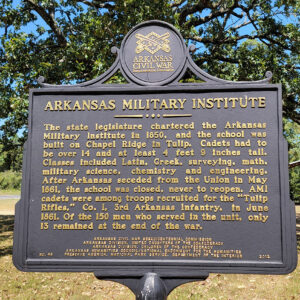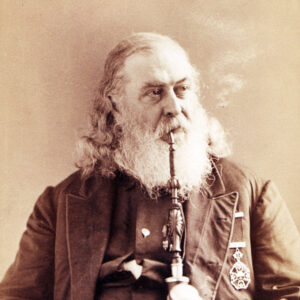calsfoundation@cals.org
Arkansas Military Institute
The Arkansas Military Institute was one of the earliest schools of its kind in the state. Established in Tulip (Dallas County) during the town’s heyday as the “Athens of Arkansas,” the school instructed male students in the subjects of the day as well as in military history, tactics, and procedures—skills some would eventually employ as Confederate soldiers during the Civil War, an event that would also signal the demise of the institution, as well as the community that supported it. By the mid-1850s, the school had shifted its focus away from military pursuits.
In August 1849, George Douglass Alexander established the Alexander Institute in Tulip for the education of both girls and boys. Less than a year later, Alexander persuaded recent Virginia Military Institute graduate Thomas O. Benton to return to Tulip to help establish the Arkansas Military Institute. Benton would remain as an instructor at the school for the rest of the first year.
In August 1850, community leaders in Tulip, many of whom were known by their military rank, gathered to discuss dividing the Alexander Institute into two schools, one for girls and the other for boys. Among those prominent citizens was the state representative, Major George Clark Eaton. Eaton became the legislative spokesman for the endeavor, and on December 17, 1850, a legislative charter in the state House of Representatives established the Arkansas Military Institute in Tulip, “providing for its superintendent, professors, examination procedures, and the use of firearms.” Alexander was appointed as superintendent, and Major Ben Borden, a former owner of the Arkansas State Gazette and Democrat, was hired to serve as the instructor for the subjects of math and tactics. Robert Thrasher was hired to serve as a teacher in both the institute and the girls’ school, which was chartered initially as the Tulip Female Collegiate Seminary.
The school, a plain frame structure, was built within the town of Tulip just off the main street on what was then known as Chapel Ridge. The field used for marching was nearby, at the crossroads of what is left of the town in the twenty-first century. The school was built on land owned by Borden, and on September 2, 1852, he sold the ten acres to the institute’s trustees for $500.
The students at the Arkansas Military Institute (also known as cadets) wore uniforms that were modeled very closely on those worn at West Point. All students of the institute were over fourteen and could not be less than four feet, nine inches in height at the time of their admission. Subjects taught included Latin, Greek, surveying, engineering, math, military tactics, chemistry, and science, among others.
Albert Pike, the famed lawyer and poet, addressed the combined graduating classes of the Arkansas Military Institute and Tulip Female Collegiate Seminary on June 4, 1852. Pike’s speech was called a masterpiece by some and was published as a small volume. In it, Pike said, “Here, on this beautiful ridge, among these green trees, hereafter, we hope, to become as illustrious as those of the Academy of Plato…”
Also in 1852, the Arkansas legislature provided for the first geological survey of the entire state. The samples from this survey and another collection created by the Antiquarian Society were originally housed in what is now the Old State House, but, after some reports of visitors pilfering items from the collections, they were moved to the Arkansas Military Institute for safety. These items were reportedly scattered by an invading army in 1864 and were never recovered.
By 1856, the Arkansas Military Institute’s emphasis had shifted from military to literary. The final examinations of 1858 were held in June for both schools and were typical for the institutions. The event and the surrounding social fanfare were covered by the Arkansas Gazette. Virtually the entire community attended the examinations, which were led at the institute by Professor W. D. Leiper, who had been appointed as superintendent the year before. This was followed a few days later by the women’s seminary exams. On the last day of exams, June 24, a musical concert was performed by students, followed by speeches by the superintendent and an alumnus of the institute, George Wilson Smith, who had returned from law school in Little Rock (Pulaski County) to attend. After the graduation, students were allowed a break from their studies.
With Arkansas following the rest of the South and seceding from the Union on May 6, 1861, the local citizens began preparing for war. By the summer of 1861, the school was closed, and on June 25, a company including several former institute students was raised under the command of Captain George D. Alexander. This unit was mustered into Confederate service as Company I of the Third Arkansas Infantry in Lynchburg, Virginia, on July 5, 1861, and served as a part of the Texas Brigade, Hood’s Division, Longstreet’s Corps, of Lee’s Army of Northern Virginia for the duration of the war. Most of the population of Tulip never returned after the war, and the Arkansas Military Institute remained closed permanently.
For additional information:
Brown, Sarah. “Dallas County Multiple Resource Area.” National Register of Historic Places nomination form, 1983. Online at https://npgallery.nps.gov/GetAsset/a71672d8-b647-4f6b-a73b-cbf44aeb418e (accessed November 18, 2022).
Collier, Capt. Calvin L. They’ll Do to Tie To!: Hood’s Arkansas Toothpicks, Third Arkansas Infantry Regiment–C.S.A. Little Rock, AR: Eagle Press, 1959.
Pike, Albert. An Address Delivered by Albert Pike, Esq., to the Young Ladies of the Tulip Female Seminary, and Cadets of the Arkansas Military Institute: at Tulip on 4th June, 1852. Little Rock, AR: Wm. E. Woodruff, 1852.
Sherwood, Diana. “Historical Societies in Arkansas.” Arkansas Historical Quarterly 11 (Summer 1952): 131–136.
Smith, Jonathan Kennon. The Romance of Tulip Ridge. Baltimore, MD: Deford, 1966.
Smith, Herschel Kennon, Jr. “Ante-Bellum Schools at Tulip, Arkansas.” Arkansas Historical Quarterly 18 (Autumn 1959): 280–286.
———. “Tulip in Her Glory.” Arkansas Historical Quarterly 17 (Spring 1958): 68–72.
Michael Hodge
North Little Rock, Arkansas
 Louisiana Purchase through Early Statehood, 1803 through 1860
Louisiana Purchase through Early Statehood, 1803 through 1860 Arkansas Military Institute Marker
Arkansas Military Institute Marker  Albert Pike
Albert Pike 




The military portion of the school ended about 1856. George Alexander, the superintendent, left to continue farming, and the new superintendent, W. Leiper, came in about 1857 and the school continued as a boys school. According to James Caldwell, the cadet adjutant and member of first graduating class, “the military school closed, and the arms, uniforms etc., returned to the state” and sent to the arsenal. This is how the cannon came to be issued out to artillery batteries as they formed. Most of the members of Co I 3rd Ark Inf were not cadets from the school nor young students from the school; most were grown, adult men from the Tulip area. Perhaps a few younger soldiers joined, and possibly a handful who had been cadets previously, but with no rosters of students to compare, this can only be speculation. These sources are found at the Arkansas History Commission: James E. Caldwell Journal; Romance of Tulip Ridge by Jonathan K. Smith, 1966 M.A. Thesis; History of Education in Arkansas by Josiah H. Shinn 1900.